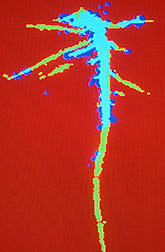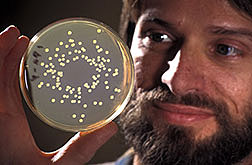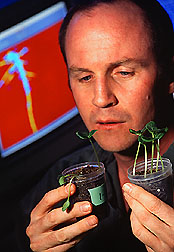A Tag-Team Knockout for Fungi
Researchers are hoping to deliver a one-two punch against underground fungi responsible for damping-off diseases that rot seeds and seedlings. Their knockout combo could be two species of bacteria that compete with the fungi in nature.
|
|
Microbiologist Daniel P. Roberts and colleagues at USDA’s Beltsville (Maryland) Agricultural Research Center are working to recruit the bacteria for use in antifungal seed treatments.
This could offer growers a natural alternative to chemicals for combating Pythium ultimum and Fusarium. These two fungi can spell disaster for an unprotected crop.
In cool, moist soils, Pythium will attack the seed of corn, cucumber, squash, watermelon, and other crops. Its accomplice, Fusarium, flourishes in warmer, dryer soils and generally attacks crop plants later in the growing season.
Pythium ultimum is a big problem for a short period of time, while Fusarium is more of a long-term problem, says Roberts, who is at ARS Biocontrol of Plant Diseases Laboratory in Beltsville. "Both of these pathogens can occur in the same agricultural field." Anticipating fungal attacks and squelching them with chemicals can meet with mixed success. Roberts and colleagues Pierre Dery, Remy Yucel, Prakash Hebbar, and Weili Mao hope to take out some of the guesswork by coating crop seeds with a living community of beneficial bacteria. Like protective guardians, the bacteria shield vulnerable young seedlings from fungal attack as they grow. In theory, mature plants that harbor such guardian bacteria in their roots may also fare better later in the growing season.
The scientists’ main recruits against the damaging fungi are strains of the bacteria Enterobacter cloacae and Burkholderia cepacia.
|
|
Roberts and colleagues didn’t discover the bacteria. But they do know the two compete with the fungi for space and plant sugars and other nutrients in underground root zones. Unlike the fungi, the bacteria don’t harm the plant. For this study, Roberts’ team first “brewed” millions of the test bacteria on special diets in a lab flask. Then they added them to sterilized peat and applied the concoction in a sticky coating on the seeds, a common lab technique in biocontrol evaluations. The two types of bacteria were applied separately and in combination.
The scientists then planted the seeds—and untreated counterparts—in a growth chamber containing soil inhabited by the fungi. After 8 days, they inspected the seedlings.
"The difference was striking," Roberts recalls.
Most notably, a majority of the nontreated plants failed to make it above the soil surface. Those that did had flimsy, water-logged stems and died shortly thereafter.
In contrast, 90 percent of plants treated with both bacteria sustained their normal growth, height, weight, and vigor. These also fared better than seedlings grown from seeds treated with either species alone.
|
|
So far, the experiments have been promising. But the ARS group plans to study the microbes further in lab, greenhouse, and field tests. Several questions still remain: for example, how long must they persist in soils to be effective—and under what soil conditions? The researchers also want to pinpoint the genes or traits by which the bacteria colonize plant roots or remain active against fungi in soils.
Finding the answers will help show how the microbes stack up against the chemical controls that growers are more familiar with using. Then it will be up to private industry to further develop the microbes as a commercial fungicide product.
Is such forecasting simply pie-in-the-sky?
One product that suggests otherwise is SoilGard, which has been developed for greenhouse use.
SoilGard's active ingredient is spores of the beneficial fungus Gliocladium virens GL-21. This fungus was originally discovered and studied by ARS researchers at the biocontrol lab and in the Floral and Nursery Crops Research Unit also located at Beltsville. GRACE Biopesticides of Columbia, Maryland, later commercialized the fungal technology under a cooperative research and development agreement with the Beltsville labs.
Applied in granular form to soils, EPA-registered SoilGard inhibits damping-off diseases caused by Pythium, Rhizoctonia solani, and other harmful fungi. It is now being considered as a promising alternative to methyl bromide, a widely-used chemical fumigant scheduled to be banned in 2001. -- By Jan Suszkiw, ARS.
Daniel P. Roberts is at the USDA ARS Sustainable Agricultural Systems Laboratory, Beltsville, MD, 20705-2350; phone (301) 504-5680 ext. 469.
"A Tag-Team Knockout for Fungi" was published in the June 1996 issue of Agricultural Research magazine.









